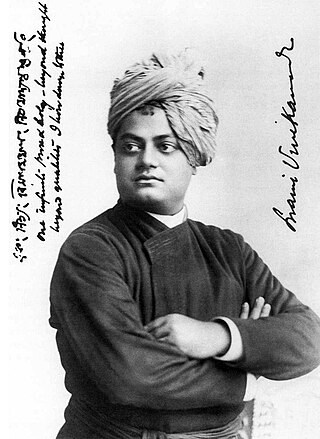
Swami Vivekananda, born Narendranath Datta, was an Indian Hindu monk, philosopher, author, religious teacher, and the chief disciple of the Indian mystic Ramakrishna. He was a key figure in the introduction of Vedanta and Yoga to the Western world, and the father of modern Indian nationalism who is credited with raising interfaith awareness and bringing Hinduism to the status of a major world religion.

Ramakrishna, also called Ramakrishna Paramahansa, born RamakrishnaChattopadhay, was an Indian Hindu mystic. He was a devotee of the goddess Kali, but adhered to various religious practices from the Hindu traditions of Vaishnavism, Tantric Shaktism, and Advaita Vedanta, as well as from Islam and Christianity. He advocated the essential unity of religions and proclaimed that world religions are "so many paths to reach one and the same goal". His parable-based teachings espoused the ultimate unity of diverse religions as being means to enable the realization of the same God. He is regarded by his followers as an avatar.

Sri Sarada Devi, born Kshemankari / Thakurmani / Saradamani Mukhopadhyay, was the wife and spiritual consort of Ramakrishna Paramahamsa, a nineteenth-century Hindu mystic. Sarada Devi is also reverentially addressed as the Holy Mother by the followers of the Sri Ramakrishna monastic order. The Sri Sarada Math and Ramakrishna Sarada Mission situated at Dakshineshwar is based on the ideals and life of Sarada Devi. She played an important role in the growth of the Ramakrishna Movement.
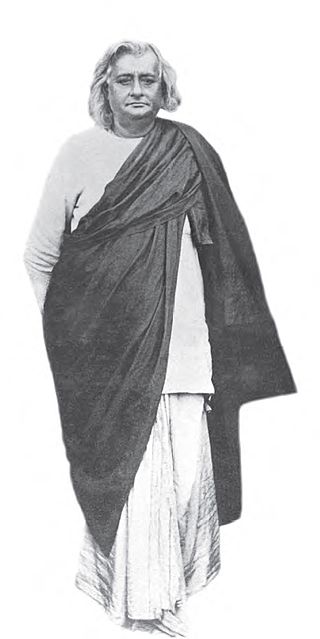
Swami Akhandananda (1864–1937) was a swami and direct disciple of Sri Ramakrishna, a 19th-century mystic. He was the third president of the Ramakrishna Mission.

Dakshineswar Kali Temple or Dakshineswar Kalibari is a Hindu navaratna temple in Dakshineswar, Kolkata, West Bengal, India. Situated on the eastern bank of the Hooghly River, the presiding deity of the temple is Bhavatarini (Kali), a form of Mahadevi or Parashakti Adya Kali, otherwise known as Adishakti Kalika. The temple was built in 1855 by Rani Rashmoni, a Zamindar, philanthropist and a devotee of Kali Maa. The temple is known for its association with Ramakrishna and Ma Sarada Devi, mystics of 19th century Bengal.

Ramakrishna Paramhansa Deva had sixteen direct disciples who became monks of the Ramakrishna Order; they are often considered his apostles. In the Ramakrishna-Vivekananda movement, the apostles have played an important role. Apart from Swami Vivekananda, the direct disciples or apostles of Ramakrishna were as follows.
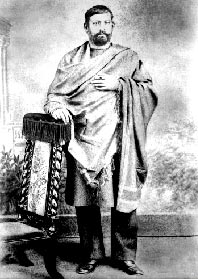
Surendra Nath Mitra aka Surendranath Mitra was one of the prominent devotees of Sri Ramakrishna Paramahamsa. He came from a very prosperous background and had the fortune of sponsoring the expenditures of the Master and his devotees when the Master lived in Calcutta in his last days. He was also known as Suresh Chandra Mitra, but Sri Ramakrishna called him "Surendra". Suresh lived in Simulia Street, the same locality as Narendranath.

Swami Vivekananda is a 1998 Indian biographical film directed by G. V. Iyer and produced by T. Subbarami Reddy. It took Iyer 11 years to finish the research work required for the film and to write the screenplay.
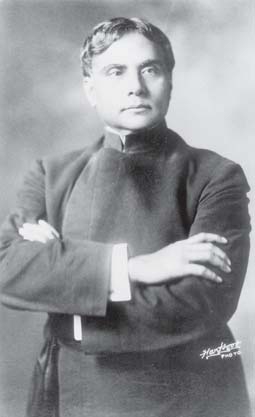
Swami Abhedananda, born Kaliprasad Chandra, was a direct disciple of the 19th century mystic Ramakrishna Paramahansa and the founder of Ramakrishna Vedanta Math. Swami Vivekananda sent him to the West to head the Vedanta Society of New York in 1897, and spread the message of Vedanta, a theme on which he authored several books through his life, and subsequently founded the Ramakrishna Vedanta Math, in Calcutta and Darjeeling.

Swami Yogananda was a disciple of Ramakrishna Paramahansa, the 19th-century mystic. He took his formal initiation from Sarada Devi, the "holy mother" of Ramakrishna paramhansa Order and spiritual consort of Ramakrishna. He was the first vice-president of Ramakrishna Mission. He belonged to the family of Sabarna Roy Choudhury, an aristocratic family of erstwhile Bengal. He had a very short life, but he played a very important role during the formative years of Ramakrishna Mission. He was also a dedicated and devoted attendant to Sarada Devi during her stay in Calcutta after Ramakrishna paramhangsha's death. He was one of the disciples whom Ramakrishna paramhangsha referred to as "Iswarakoti" or the "ever perfect soul".

Biley or Bilay is a 2012 Bengali drama created by Bengali theatre group Lokkrishti, This is a dramatisation of the life and works of Swami Vivekananda. Debshankar Haldar played the lead role. Phalguni Chattopadhyay directed this drama and Ujjwal Chattopadhyay was the playwright.
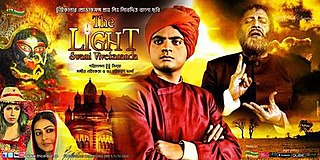
The Light: Swami Vivekananda (2013) is a bilingual film directed by Utpal (Tutu) Sinha and produced by Tri Colour productions private limited. The film is based on the life and teaching of Swami Vivekananda. The film was a tribute to Vivekananda on the 150th anniversary of his birth. The film was dubbed in 18 languages.

Swami Vivekananda was an Indian Hindu monk. He was a key figure in the introduction of the Indian philosophies of Vedanta and Yoga to the western world. The 150th birth anniversary of Swami Vivekananda was celebrated all over India and in different countries in the world. Ministry of Youth Affairs & Sports of India decided to observe 2013 as the year of 150th Birth Anniversary of Swami Vivekananda. Year-long events and programs were organised by different branches of Ramakrishna Math, Ramakrishna Mission, central government and different state governments of India, education institutions, youth groups etc. Bengali film director Tutu (Utpal) Sinha made a film The Light: Swami Vivekananda as a tribute to Swami Vivekananda on his 150th birth anniversary. The movie was released on 23 August 2013.

My Master is an English book combined from two lectures delivered by Swami Vivekananda in New York and England, published in 1901.

Swami Vivekananda, the nineteenth-century Indian Hindu monk, is considered one of the most influential people of modern India and Hinduism. Rabindranath Tagore suggested to study Vivekananda's works to learn about India. Indian independence activist Subhas Chandra Bose regarded Vivekananda as his spiritual teacher. Mahatma Gandhi said that after reading the works of Vivekananda, his love for his nation became a thousand-fold.

The relationship between Ramakrishna and Vivekananda began in November 1881, when they met at the house of Surendra Nath Mitra. Ramakrishna asked Narendranath to sing. Impressed by his singing talent, he invited him to Dakshineswar. Narendra accepted the invitation, and the meeting proved to be a turning point in the life of Narendranath. Initially Narendra did not accept Ramakrishna as his master and found him to be a "mono maniac", but eventually he became one of the closest people in his life. Ramakrishna reportedly shaped the personality of Narendranath and prepared him to dedicate his life to serve humanity. After the death of Ramakrishna, Narendra and his other monastic disciples established their first monastery at Baranagar.

Vivekananda's prayer to Kali at Dakshineswar is an event which occurred in September 1884 when Swami Vivekananda, following the suggestion of Ramakrishna, went to the Kali temple of Dakshineswar with the intention to pray for financial welfare, but ultimately prayed for pure knowledge, devotion and renunciation. This event has been a subject of scholarly studies and is considered as a significant event in the life of Vivekananda, who initially revolted against idol-worship but now accepted and prayed before an idol of Kali. This incident added a new change to Narendra's devotion and knowledge.

Sarat Chandra Chakravarty was a direct householder disciple of Swami Vivekananda and was the chronicler of "Diary of a Disciple" which is one of the major sources of first-hand information on Vivekananda's biography and teachings in the later stage of his life. Sarat Chandra was intimately connected with the Ramakrishna Order throughout his life, and even before the return of Swami Vivekananda from the West in 1897 he had been associated with the old monastery in Alambazar and with the direct disciples of Sri Ramakrishna. He was also a Sanskrit scholar and was a postmaster by profession in the British Government service.
Alambazar Math is the second monastery of the Ramakrishna Order established in February 1892, which remained the order's headquarters till February 1898, when it was finally moved to Belur village on the bank of Ganga.

Gopaler Ma was a devotee and a householder disciple of Sri Ramakrishna, the saint and mystic from Bengal. Her birth name was Aghoremani Devi, but she came to be known as Gopaler Ma among the devotees of Sri Ramakrishna, owing to her intense motherly love for Sri Ramakrishna as "Gopala" or baby Krishna. She was famous for her divine visions of Lord Krishna as a baby and her devotion to the ideals of Sri Ramakrishna. In her later years, she was very close to Swami Vivekananda and Sister Nivedita. She spent the last few years of her life with Sister Nivedita.



















